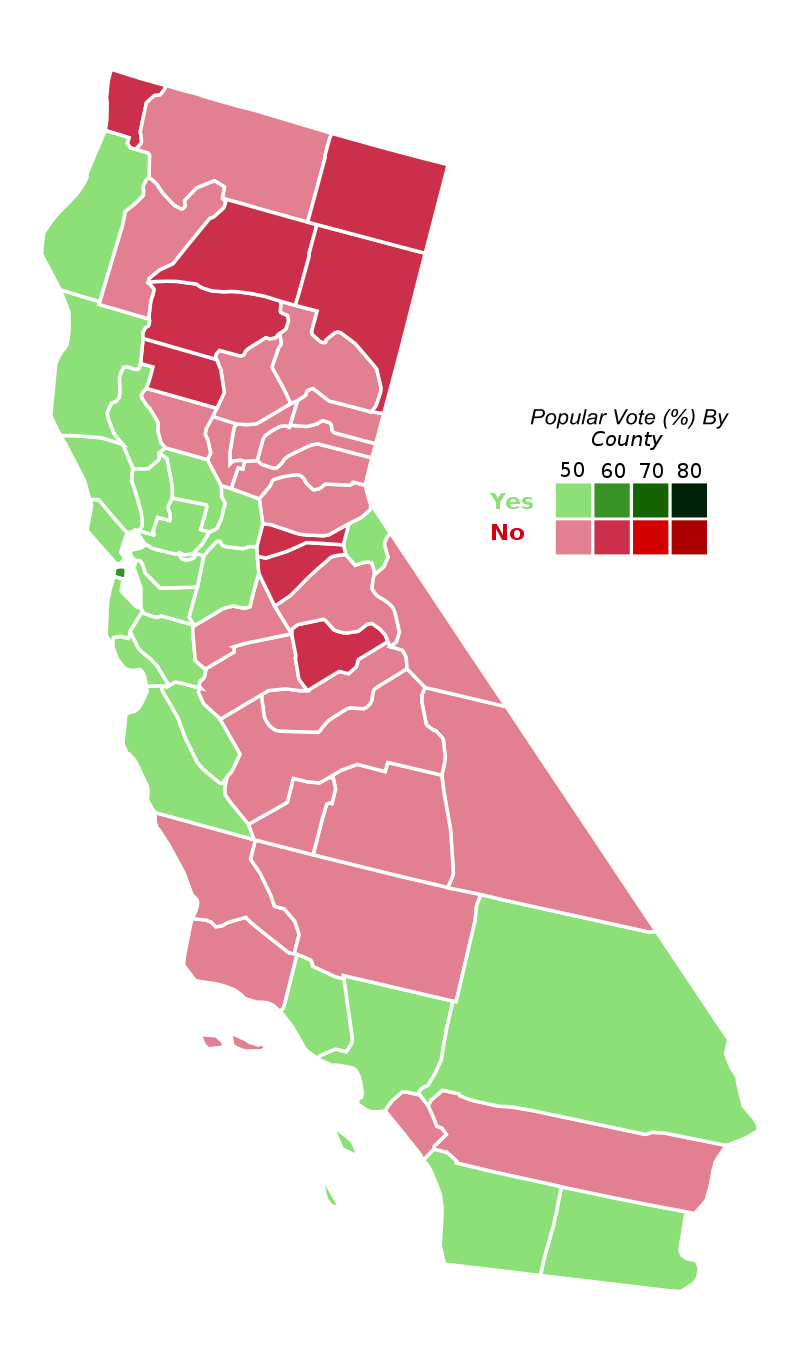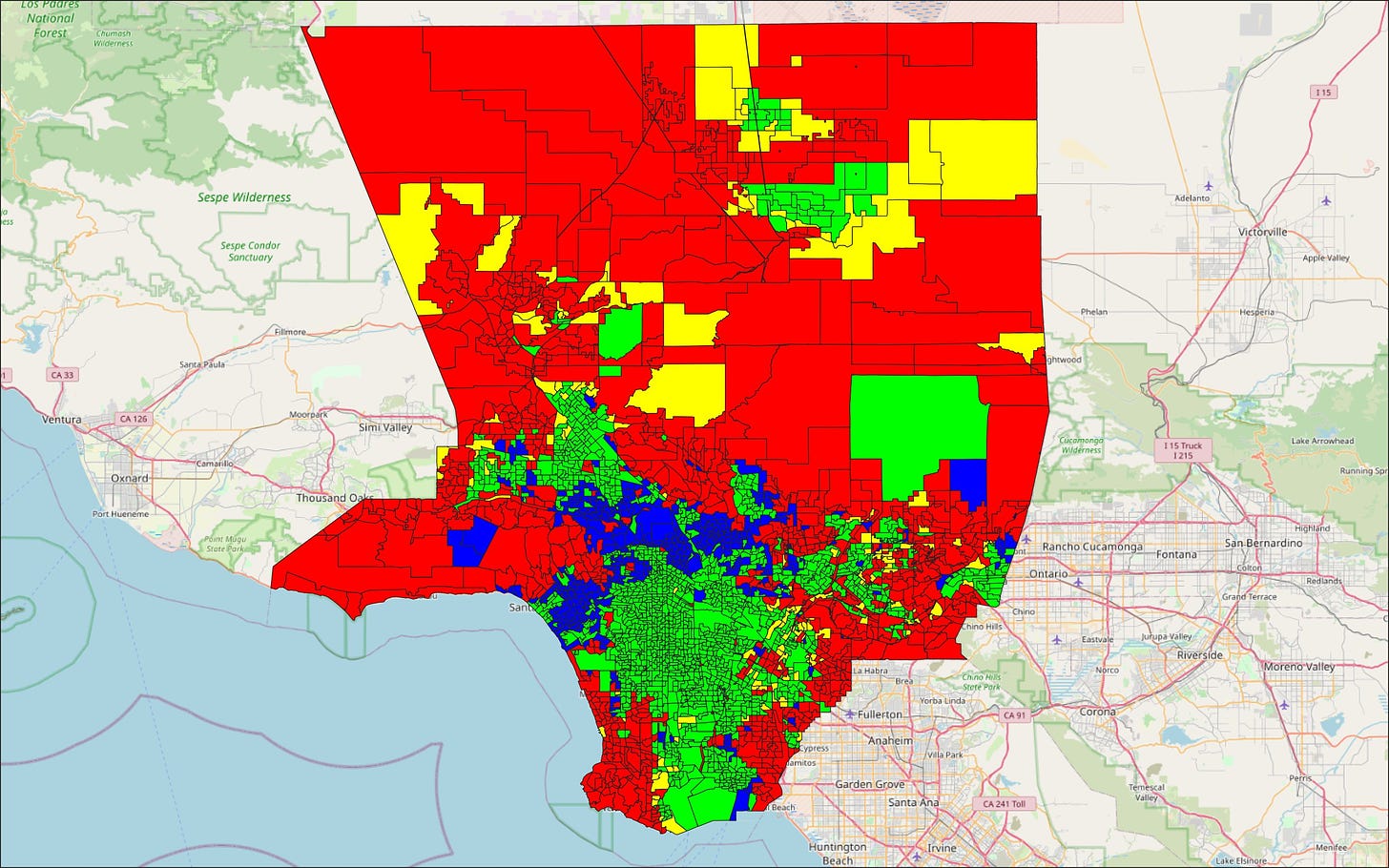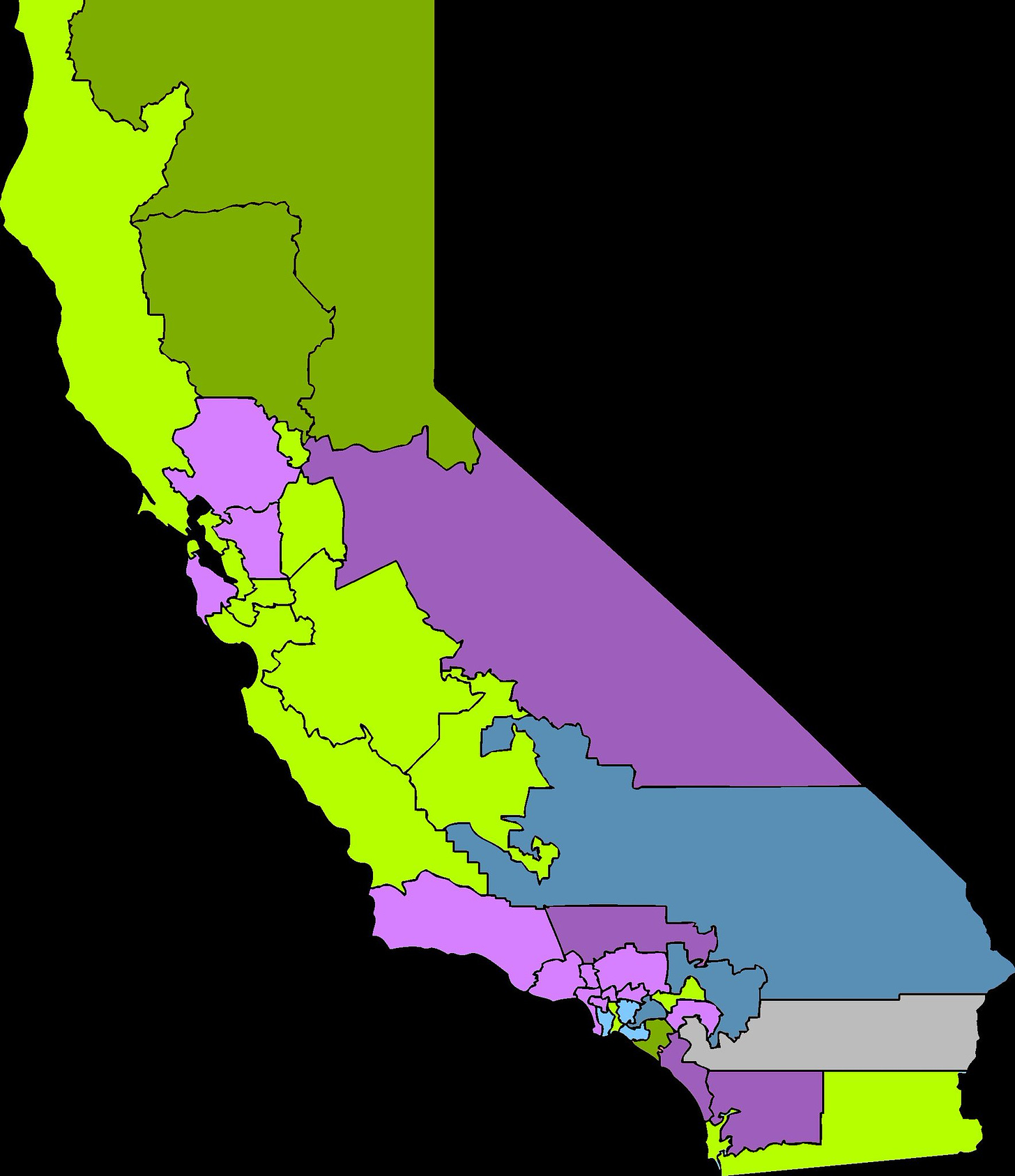The Politics of Housing and Property Taxation in California
California’s existing framework on property taxation has its origins in a tax revolt that led to the passage of prop 13 in 1978, a citizens initiative which freezes property taxes at the rate of when a property is first assessed. California’s property taxation laws have unique attributes but overall tax rates rank in the mid-range nationally, compared to the highest in Texas, Illinois, and New Jersey, and the lowest in Hawaii, Alabama, and Colorado.
Besides the debate about whether tax rates are too high or too low, there is the issue of split roll. This means that under prop 13 one’s neighbor often pays vastly less in taxes on a home that is worth the same market value due to living their much longer. The tax fairness map shows the degree to which prop 13 subsidizes the ultra-wealthy and the extreme tax disparities that exist within the same neighborhoods. Split role is particularly unfair to new buyers and protects the elderly but at the expense of young families.
The left’s opposition to prop 13 is primarily about the tax revenue, especially for funding public education, however the Democratic Party in California has failed to propose any reasonable reform to split role that would be fairer to families and new buyers. Other issues include incentivizing empty nesters to stay put rather than downsizing, which would not be a problem if there was a greater supply. Due to the housing scarcity, prop 13 has contributed to the ageing of the most desirable neighborhoods and a lack of inventory for younger buyers and families looking to get a foothold. It has even caused some wealthy California cities to go bankrupt.
Last fall two measures were put forth on the ballot that would have restructured prop 13. Proposition 15, which failed, would have ended prop 13 protections but only for commercial real estate. The proposition failed due to confusion, on the part some, as to if the measure would apply to residential properties, and concern, for others, that it would be a slippery slope to ending tax protections for residential property.
I reluctantly supported prop 15, but with some reservations. The best case to be made for supporting that measure was that it would have been good for urbanism due to taxing underutilized properties such as parking lots, vacant lots, and empty storefronts. This could have improved blighted urban areas, and helped retrofit suburbia by incentivizing mixed use development, and the creation of more walkable communities.
The other reason for support was the taxation of legacy corporations and the wealthiest commercial landlords who have an unfair advantage over newer businesses. Some extreme examples of beneficiaries under the existing laws include the wall street firm “The Blackstone Group/Boston Properties” underpaying by: At least $6 million,” “DisneyUnderpaying by: At least $25.8 million per year (and probably way more)”, “Los Angeles Country ClubUnderpaying by: $1.6 million”, and “Chevron Underpaying by: $100 million.” The potential downsides of this measure were the lack of accountability for the revenue that could further empower inefficient state bureaucracies, and also concerns about passing down the costs to consumers, even if this measure did offer protections for small businesses.
The other measure, which did pass, was prop 19. Prop 19 makes prop 13 protections portable for those looking to relocate, but only for those over the age of 55. Making prop 13 portable benefits retirees but eliminates tax protections for heirs and is an overall tax hike, as the tax raise on heirs is greater than the short term protections for the elderly. The tax increase on heirs would apply to homes worth $1 Million or more which could impact middle class millennials taking into account whether inheritance is split up between heirs and that California’s median home price reached an all-time high at “ $758,990, up 8.6 percent from February and up 23.9 percent from March 2020.”
The passage of this measure is flat out ageist and could exacerbate the intergenerational wealth gap in a state where the median net worth of Baby Boomers is $230,000 compared to Millennials with a net worth of $10,000. California’s Boomers also have homeownership rates close to the national average, but those of ages 25 to 34 have rates approximately 40% below the national average.
However there are some incentives for older homeowners to downsize which has led to a spike in property transfers to heirs which could open up new listings, potentially easing demand in some places while increasing demand in others. This is why, besides senior citizen special interests, the primary backing was from the real estate industry. The passage of Prop 19 grants well-off seniors financial perks but with the catch that their descendants pay up. It is the worst of both worlds in that it partially fulfills an agenda to redistribute wealth away from the middle class but is indirect by passing down the taxes to heirs rather than taxing wealthy homeowners directly.
Even though the measure would increase tax revenue and is opposed by many California Republicans, there was some progressive opposition to prop 19 in that it could impact the racial wealth gap because those who benefit from the tax breaks “have higher incomes and are more economically secure”. They “are long-term homeowners, many with access to substantial home equity, with more than half owning homes worth a half-million dollars or more, according to Budget Center analysis.”
Despite these concerns, the measure was backed by the Democratic establishment in California. There was support for both prop. 15 and prop.19 from Governor Gavin Newsom (D), State Controller Betty Yee (D), and the California Democratic Party. Opposition to both measures was from the conservative anti-tax organization and architect of the original prop 13, the Howard Jarvis Taxpayers Association. Support for prop. 15 but opposition to prop. Prop. 19 was from the ACLU of Southern California and the League of Women Voters of California, and support for prop. 19 but opposition to prop. 15 was form California NAACP State Conference, California Black Chamber of Commerce, California Business Roundtable, and the California Hispanic Chambers of Commerce.
California votes on Prop 15
Source: Wikipedia
California votes on Prop 19
Source: Wikipedia
LA votes on Prop 15 & 19
Red = No on prop 15 and no on prop 19
Yellow = No on prop 15 and yes on prop 19
Green = Yes on prop 15 and yes on prop 19
Blue = Yes on prop 15 and no on prop 19
This in-depth map of how Los Angeles County voted shows a picture of the political paradigm and voter demographic that is much more nuanced than polarization between support for high vs. low taxation. For instance, the no votes on both prop 15 and 19 were from wealthier areas such as Malibu and Beverly Hills but also from middle class conservatives in the north county suburbs. The yes on both measures votes were generally from lower income inner city areas such as East and South LA but also from those that are ideologically leftwing such as Santa Monica. The yes on prop 15 but no prop 19 votes, (how I voted, ironically) were from the well-off but urban parts of LA that have a lot of millennial young professionals: the demographic of likely heirs who would be taxed down the road.
The no on prop 15 but yes on prop 19 vote was a demographic whose voting record was victorious and was well represented among the more moderate Democrat voting counties in California but was a much smaller niche in LA, with pockets in the San Fernando Valley, the San Gabriel Valley, the South Bay, and the Harbor area. My assessment of these voters is that they include many middle class but older homeowners who are likely to be moderate democrats and also a demographic of well off DINKS: Duel income no kids who will benefit the most from prop 19.
There are many different angles to the demographic divide on property taxation that touch upon divisive identity issues of age, race, and class. On one hand prop 19 could be viewed as a grey/brown alliance against younger Whites within California’s Democratic Party. Within progressive politics, however, there is also resentment against the disproportionately White landed gerontocracy. While intergenerational tensions factor into the debate about wealth equity, the younger poor and the younger middle class have interests that depart on aspects of property tax policy. This applies to the demographic that voted Yes on prop 15 but no on prop 19, that includes many younger White liberals who voted their economic interest.
Another demographic component to property taxation is that younger Whites have a disproportionately greater share of wealth from inheritance while upwardly mobile minorities and high skilled immigrants have wealth that is newer. Besides prop 13 contributing to the ageing of well-off areas, there is also a partial limit to gentrification which is why the left is hesitant to push for a full repeal and many liberal cities across the nation have frozen property tax assessments in lower income areas that are undergoing gentrification.
While the current split role tax model is deeply flawed, there is potential for a massive tax increase on property and inheritance paving the way for a rent based, Great Reset model of capitalism, which is detrimental to an ownership society and passing down of generational wealth. For instance the built to rent suburbs promoted by the Wall Street Journal and the private equity firm Black Rock taking advantage of NIMBYism and low interest rates. This relates both to the inter-generation wealth gap as the asset bubble is paying the baby boomers pensions while driving up the costs for younger buyers. It also relates to the YIMBY cause as VOX and some YIMBYs consider blaming private equity firms to be a distraction from the limited supply of housing.
The YIMBY vs. NIMBY debate on up-zoning to accommodate more housing is connected to the property tax debate but it is foolish to assume that all YIMBYs are for higher property taxes while all NIMBYs support prop 13 in its current form. Zoning reform does touch upon many of the same identity issues such as single family zoning being linked to racism and issues of intergenerational warfare such as a comment from an older NIMBY in the Silicon Valley suggesting young families should leave the area, or the meme of diverse youthful YIMBY activists vs. crusty old White NIMBYs. However the political and demographic breakdown of support for zoning reform is much more complex as there are affluent NIMBYs of color and NIMBY groups such as Housing is a Human Right that make progressive platitudes for opposing up-zoning or an op-ed expressing concern that zoning changes could put a hurt on Black homeownership in California.
There has not been a citizens referendum on zoning so it’s hard to get an in depth analysis but there have been votes on zoning in the legislature. The boldest zoning reform measure was SB 50 which would have dramatically up-zoned areas near transit and job centers statewide, a measure that was voted down by the state senate.
California State Senate Votes on SB 50
Purple opposed, green in support (light for Democrat and dark for Republican), and blue abstaining:
Source: Legal Planet
What is notable about the votes is that the breakdown in votes was based more around class rather than partisan politics. For instance there was opposition from much of the democratic affluent coastal suburban districts, in Southern California and the Silicon Valley, as well as Republicans in both suburban and rural areas. On the other hand there was Democratic support from the urban cores of San Francisco and the East Bay, and in some poorer districts, and there was Republican support in Orange County and some of the rural parts of Northern California.
One of the more recent zoning reform proposals is SB 9 which would which would allow homeowners statewide to subdivide their properties into smaller lots, legalizing fourplexes in areas currently zoned for single family homes. Unlike with SB 50, the state assembly’s vote was divided along partisan lines with Democrats voting yes and Republicans voting no but the LA County Democrats came out against this measure, showing that there is still a strong NIMBY strain in California liberal politics.
These progressive allies of NIMBYs often make the case on anti-gentrification grounds but neglect the fundamentals of supply and demand in real estate. There is a strain of liberal politicians in California who will oppose any market rate housing and only support a development if it is mostly affordable housing as a way to appease both the left and wealthy NIMBY homeowners.
To look at the hypothetical demographic impacts of up-zoning: age does seem to be a big divide and the class divide plays out as well, even if there is a segment of the wealthy that does want more high end housing. As far as race goes up-zoning could “diversify” many suburbs but at the same time would numerically increase the population among all groups, including Whites as California would attract people from all over the nation if it weren’t for restrictive zoning.
The YIMBY movement is generally a younger movement, but is also fairly divide along class and ethnic lines. It is ideologically diverse as well. For instance there is Market Urbanism making the case for liberalizing zoning from a fiscally conservative point of view. If Republicans were smart they would adopt zoning reform as a way to own the Californian Limousine Liberals they like to call out on hypocrisy. YIMBYism overall could be incorporated into a pro-middle class millennial populist movement. It is important to look at these issues of zoning and taxation on a case by case basis rather than intersectionally. California, despite being a one-party state, is made up of many political demographic tribes with different diverging economic interests so it is inaccurate to assume there is an aligned political divide and this also creates barriers for finding one monolithic statewide solution to these problems.






